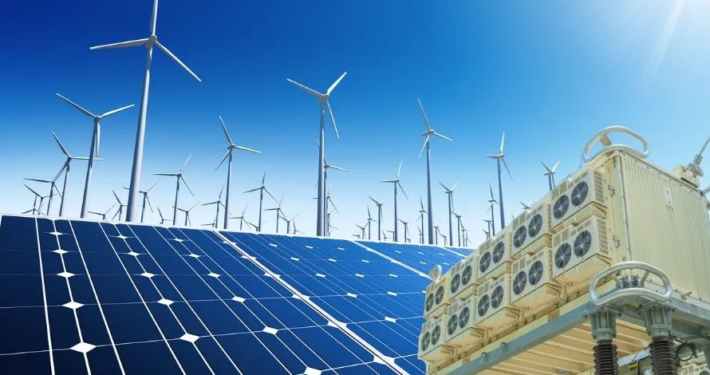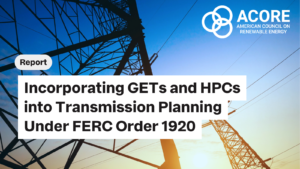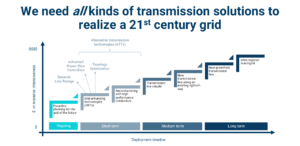
Series compensation without creating Sub-Synchronous Resonance (SSR) risk
August 30, 2023
System operators around the world use series compensation to increase transmission capacity on their existing grids. However, many conventional series compensation solutions create Sub-Synchronous Resonance (SSR) on the system which poses a high risk to nearby generating units. In this article, Francesca Madia Mele, explains how SmartValve can deliver series compensation on transmission grids without creating SSR risk.

Over the last few decades, the urgent need to mitigate climate change, coupled with the increasing demand of electricity, has driven a shift towards integrating more sustainable energy sources in the power generation mix. The incorporation of renewable sources offers both benefits and challenges for system operators. While the reduction of the generation carbon footprint is very important to delivering on climate targets, incorporating more and more renewables into the generation mix significantly impacts grid stability and operation. Therefore, the integration of grid technologies to enhance grid flexibility and resilience is essential.
Series compensation is often used by system operators to improve the efficiency, stability, and reliability of the transmission system. In the modern scenario, series compensation supports the increase of the transmission capacity while preserving efficient power transfer. The latter is a main concern as renewables sources are typically located far from urban areas, data centers and manufacturing plants, where the demand for electricity is highest. Series compensation can be achieved by either installing conventional series capacitors or deploying Flexible AC Transmission System (FACTS) devices like SmartValve.
Unlike conventional series capacitor, SmartValve is a modular Static Synchronous Series Compensator (m-SSSC) capable of injecting voltage independently of the line current and primarily at the fundamental system frequency. This injection does not affect the total effective reactance of the system at sub-synchronous frequencies. This characteristic is particularly important because one of the drawbacks of conventional series compensation solutions is Sub-Synchronous Resonance (SSR), which poses significant risks for generating units connected in the electrical vicinity of the solution.
SSR refers to the undesired energy exchange between the electrical characteristics and the mechanical components of the grid. It can occur at one or more frequencies below the fundamental system frequency, and can result in the torsional vibration of the turbine-generator shaft and, in extreme cases, damage of the equipment and electrical instability. SSR is categorized into four types: Sub-Synchronous Torsional Interaction (SSTI), Torque Amplification (TA), Induction Generator Effect (IGE), and Sub-Synchronous Control Interaction (SSCI). In the first two, SSTI and TA, the electrical behavior of the system causes the rotor torsional oscillation, while IGE and SSCI pertain solely to the oscillation at electrical level and without any mechanical involvement.
To ensure that SmartValve does not increase the risk of undamped oscillations caused by SSR, the Analytics team developed a simple yet effective systematic approach to assess the impact of connecting SmartValves, and other FACTS devices, in series with a transmission line. The methodology considers a generic stable network, of which a highly detailed model is not required, and uses the frequency sweep method in conjunction with a thorough analysis of the system reactance with respect to the resonance frequency. A comprehensive dissertation of the study methodology is available at https://www.smartwires.com/2022/10/22/ssr-implication-assessment-using-modular-facts/.
The study’s results demonstrate that the integration of Smart Wires’ technology, through the installation of a SmartValve system in series with a transmission line, does not have a negative impact on the system stability at sub-synchronous level, and the probability of amplified sub-synchronous oscillations is negligible, especially for systems exhibiting inductive behavior.
In this era of increasing reliance on renewable energy sources, the adoption of m-SSSC devices, like SmartValve, emerges as a beacon of progress. Its seamless integration does not only help system operators to rapidly integrate renewable energy, but it also increases operational flexibility and safeguards the foundational stability of our transmission systems. By embracing grid enhancing technologies such as SmartValve, we are reinforcing the long-term resilience of our energy grids for the benefit of future generations.
Smart Wires Analytics team offers comprehensive power systems consulting services, encompassing expertise in conducting thorough SSR investigation ranging from preliminary analysis based on frequency sweep method to detailed time-domain studies for risk assessment, along with providing, where possible, recommendations for SSR risk mitigation. If you’d like to learn more, get in touch with us.
Contributing expert
Dr. Francesca Madia Mele is a Regional Business Manager at Smart Wires, where she leads a geographically distributed interdisciplinary team of engineers whose skills range over power systems modeling, control, planning and operation. Dr. Mele holds a Ph.D. in Electrical Engineering and a Master’s degree in Control and Automation Engineering. Throughout her career, Dr. Mele has worked on numerous projects related to power systems planning, modeling, control, performance assessment, and optimization. She is committed to advancing grid modernization through the development of cutting-edge technologies and tools.
For press related purposes, please contact us at marketing@smartwires.com.
Dive deeper into related content
Explore our products and services
Talk to our experts



